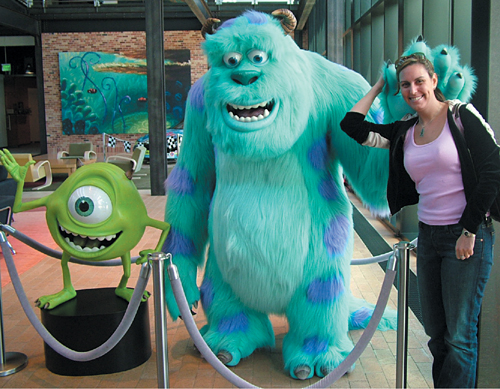

It's not hard to believe that Pixar's masterpiece "Finding Nemo" is the world's highest-grossing animated film. But here's something you probably didn't guess--"Finding Nemo" is the ninth-highest-grossing film of all time, having earned more than $850 million worldwide.
"Nemo" is just one of several blockbuster animation successes from Pixar. I had a chance to find out how they do it when the usually secretive Pixar Animation Studios invited me to tour its headquarters in Emeryville, Calif.
FIRST LOOK
The first thing I see when I walk through Pixar's front door are two life-size replicas of the stars of the 2001 hit "Monsters, Inc." With these lovable, furry creatures serving as the welcome committee, it's no wonder I feel happy right away.
A number of employees whizz past on scooters (provided by Pixar to get around the compound), while others gather at the badminton court in the lobby. In addition to this, Pixar has a "university" that offers employees an extensive range of free classes such as sculpture and karate. This is one cool place to work.
My guide is Randy Nelson, who holds the title of Dean of Pixar University. To provide an overall sense of what goes into making an animated film, Nelson takes me to the "Finding Nemo" gallery, which includes drawings and original sketches from the making of the film. According to Nelson, the artists' greatest challenge is making the animated characters appear to have human emotions.
Animation has come a long way. For example, when creating the ocean for "Nemo," the development team went so far as to include particulate matter (tiny particles that look like specks of dust in the water). Throw in the constant movement of the ocean, the lighting patterns on the ocean floor, and the reflection and refraction of light above and below the water, and you'll find a more sophisticated ocean than the one in "The Little Mermaid."
In this area, I also see how these stories are developed using storyboards--essentially a comic book version of what the movie will look like before any animation is done.
0'S AND 1'S
Once the story line and the characters have been developed, it's time to bring them to life using a massive amount of computing power. Pixar uses a RenderFarm that consists of 1000 Intel processors running Linux with a total of 2 terabytes (1 terabyte is approximately a thousand billion bytes) of RAM and 60 terabytes of disc space.
This renders the animation--think of it as painting digital pictures. The computers create objects using a 3-dimensional software modeling program. The software computes all the necessary calculations to figure out the exact color of each pixel, and puts the pixels together to form a picture. It takes 6 hours to render just one frame of a Pixar movie--an image that lasts one twenty-fourth of a second. It's easy to understand why the artists don't take rendering lightly.
So the next time you watch a Pixar movie (the superhero film "The Incredibles" will be released in November 2004), remember what it took to get these Images to the big screen, and be thankful there are lots of creative, patient folks in California riding scooters and drawing fish.
Article from Popular Mechanics, July, 2004. All rights belong to them, not me.
Animators used Red Hat Linux 7.2 to create everyone's favourite ogre
Robert Jaques, vnunet.com 29 Jun 2004
DreamWorks, the animation company behind Shrek 2, has raised the curtain on the technology which made the blockbuster possible.
Linux played a key role in creating the film, which had its London premiere yesterday and enjoyed the biggest opening weekend ever for an animated film on its release in the US.
DreamWorks needed as much computing power as possible to implement newly developed computer graphics techniques.
These included subsurface scattering for more realistic skin, global illumination for more realistic lighting, better looking hair and larger crowd scenes with more complex characters than seen in the original Shrek.
Over 330 Hewlett Packard workstations running Linux were used by digital artists to create the animations.
The xw8000 workstation featured Red Hat Linux 7.2, dual-Intel Xeon 2.4GHz processors, nVidia Quadro 4 XGL graphics cards, 2GB RAM and dual monitors.
The hefty provision of RAM allowed animators to store more frames of animation, while the faster speed of the processors allowed recalculated frames to have more detailed geometry, which helps the animators to pre-visualise and make decisions before rendering.
At the back end, the Shrek 2 render farm was comprised of 347 LP-1000 1.2GHz P3 dual processor servers with 2GB of RAM and 433 ProLiant DL360 2.8GHz P4 dual processor servers with 4GB of RAM.
Some portions of the film were rendered remotely at HP Labs in Palo Alto.